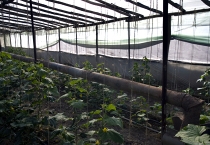Palestine

In Palestine, the RNE-WEPS project is implemented in collaboration with the Ministry of Agriculture and the Palestinian Water Authority and is guided by the multidisciplinary team of the water scarcity initiative that gather key stakeholders interested in water issues (see country team and partners).
Background
The Occupied Palestinian Territory has a total area of 6 020 km2. The West Bank is a landlocked territory on the west bank of the Jordan River with a total area of 5 655 km2, surrounded by Jordan to the east and Israel to the south, west and north. The majority of the Palestinian territories in the West Bank are still under full Israeli control (Area C). Despite the Israeli withdrawal from the Gaza Strip, Palestinian farmers have restricted access to land in buffer or border areas (40 percent of Gazan agricultural land).
The climate in the Occupied Palestinian Territory is predominantly of the eastern Mediterranean type with cool and rainy winters, hot dry summers and an annual rainfall in the range of 100-700 mm. The water resources include mainly groundwater and a little bit of surface water. The agriculture sector in Palestine contributes to food security and is responsible for around nine percent of total employment in Palestine. Women supply about 87 percent of the labor input in livestock production and 54 percent in plant production (mostly in rain fed agriculture). Despite their major contribution to agricultural labor, many rural women carry out this work unpaid.
Twenty percent of the total area of Palestine is used for agriculture (90 percent West Bank, and 10 percent Gaza Strip). Rain fed agriculture is dominant representing 81 percent, while irrigated areas cover 19 percent, mainly located in the Gaza Strip and the Jordan Valley. Agriculture in Palestine is a family business where women play a major role in the manual agricultural practices. It is important to investigate both irrigation efficiency and water productivity. Application efficiency of irrigation systems is good ranging between 75-90 percent for drip and 65-75 percent for sprinklers. Most of the losses occur in the water conveyance systems. There are no actual estimates of water productivity (bio-physical or economic) except scattered statistics.
Some of the main gaps highlighted for the water use in agriculture: Moderate irrigation efficiency, particularly of conveyance systems with open canals, no monitoring system and no actual measurement of water quantities or water productivity, lack of water storage capacities, small agriculture holdings (75 percent less than 10 dunums), Use of traditional practices and low financial capacities, Weak post-harvest processing capacities (skills, technologies, equipment), Low competitiveness (occupation, high transaction costs, limited access to markets, low marketing capacities, limited agro-business), Conservative social customs and traditions restrict women's engagement in agriculture. Limited ownership of agricultural assets (7.2 percent of land holders are female), weak ability to access finance, low participation in agricultural cooperatives.
